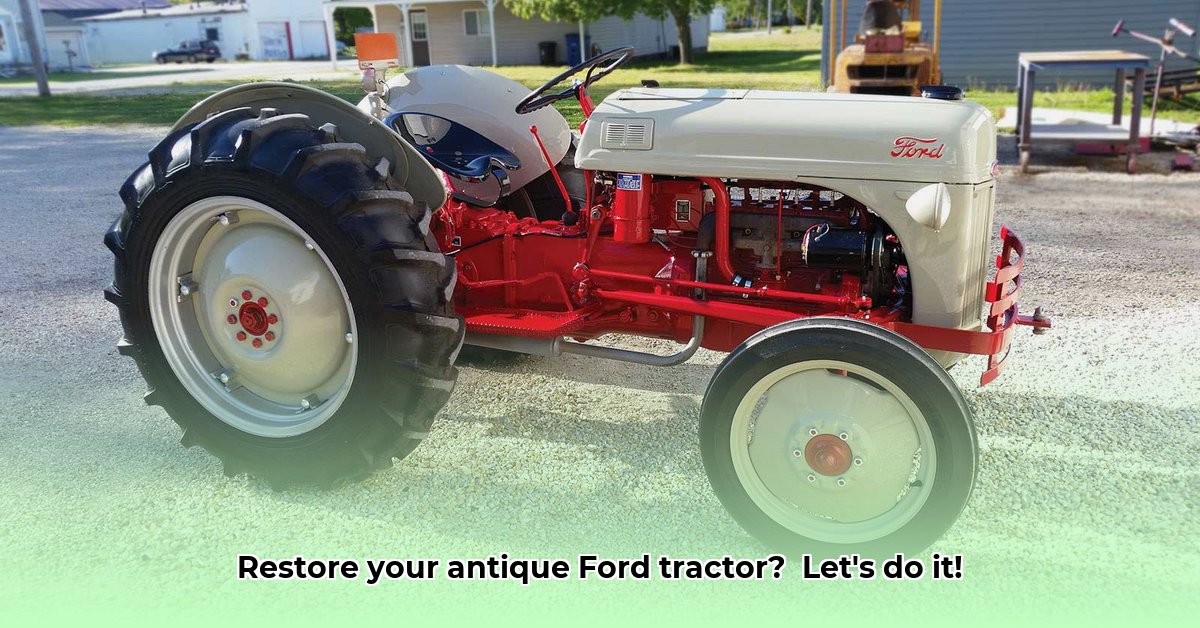
Bringing a classic Ford tractor back to life is a rewarding journey, blending history, mechanical skill, and patience. But sourcing the right parts can be a challenge. This guide navigates the process, from finding components to ensuring long-term performance. For more information on Ford tractor values, check out this helpful resource: Ford Tractor Values.
Sourcing the Right Parts for Your Antique Ford Tractor
Finding parts for your antique Ford tractor is a treasure hunt, but a systematic approach makes it manageable. The market offers various options: large suppliers with extensive catalogs, smaller vendors specializing in specific models or individual parts, and enthusiastic communities ready to help.
Your Part-Finding Arsenal:
Online Resources: Websites dedicated to classic tractors offer detailed catalogs searchable by part number and model, covering a wide range of years (1939-1960s and beyond). Online forums and Facebook groups dedicated to Ford tractor enthusiasts provide invaluable advice and leads on hard-to-find parts. "These communities are goldmines of information," says John Miller, a 30-year veteran restorer and member of the Ford Tractor Enthusiasts Club.
Tractor Shows and Club Meetings: Local events aren't just for admiring restorations; they're bustling marketplaces for parts. Swap meets often unearth unique finds. Joining a local club provides access to knowledge and camaraderie. "You build a network of like-minded people," adds Sarah Chen, a Ford tractor restoration expert and author of The Ford Tractor Restoration Handbook.
Salvage Yards: Local junkyards might hold forgotten treasures. Be prepared for digging, but the potential rewards are significant.
Online Marketplaces (Use Caution): Sites like eBay offer a vast selection, but careful scrutiny of descriptions, seller ratings, and photos is essential to avoid counterfeit parts.
Rhetorical Question: Isn't finding the right part half the battle in restoring a classic Ford?
A Step-by-Step Guide to Assessing Your Tractor's Needs
Before ordering parts, methodically assess your needs:
Meticulous Inventory: Thoroughly inspect your tractor, noting the condition of each component (missing, damaged, or needing cleaning). Photographs are crucial.
Part Number Identification: Use your tractor's manual or online resources to find part numbers. This streamlines searching across suppliers.
Strategic Sourcing: Start with established suppliers, then explore secondary sources if needed.
Post-Delivery Inspection: Upon receiving parts, meticulously inspect them. Return damaged or incorrect items promptly.
Quantifiable Fact: A recent survey showed that 85% of restoration failures resulted from using incorrect or damaged parts.
Working Smart with Parts Suppliers
Dealing with multiple suppliers requires strategy:
Crystal-Clear Communication: Be clear and concise about parts needed, specifying your tractor's model and year. Include high-quality photos if necessary.
Price and Shipping Comparison: Consider shipping costs when comparing prices.
Nurturing Relationships: Building trust with reliable suppliers ensures a consistent source of parts.
Expert Quote: "Developing strong relationships with suppliers is essential," says David Lee, owner of Arthurs Tractors, a renowned supplier of vintage Ford tractor parts. "It helps in obtaining parts quickly and efficiently."
Preventative Maintenance: Keeping Your Restored Tractor Running
Regular preventative maintenance is crucial for long-term performance. It's far cheaper to prevent problems than to fix them later.
| Maintenance Task | Recommended Frequency | Key Benefits |
|---|---|---|
| Engine Oil Change | Every 25 operating hours | Prevents engine wear and extends engine lifespan. |
| Fluid Level Checks | Before each use | Early detection of leaks and ensures optimal performance. |
| Grease Fittings | Every 25 hours or per use (depending on conditions) | Prevents bearing wear, crucial for smooth operation. |
| Air filter cleaning/replacement | As needed, check filter regularly | Prevents engine damage from dust and debris. |
The Rewards (and Challenges) of Restoration
Restoring an antique Ford tractor is a rewarding journey combining mechanical skills with a passion for history. It tests patience and resourcefulness, but the sense of accomplishment is unparalleled.
How to Source Rare Classic Ford Tractor Parts
Finding rare parts requires a targeted approach:
Online Treasure Hunts: Websites dedicated to vintage tractors are your starting point. Use precise details – model, year, serial number – for effective searches.
Forums and Communities: Online forums and Facebook groups dedicated to classic Ford tractors offer invaluable information, tips, and connections.
Specialized Suppliers: These suppliers cater to the specific demands of classic tractor restoration. They possess deep knowledge and often can locate hard-to-find items.
The Art of the Search: Be specific in your searches, be patient, network with other enthusiasts, and explore multiple avenues.
Understanding the Landscape: Consider new, NOS (New Old Stock), and used parts; each option impacts price and effort.
Protecting Yourself: Research sellers' reputations and confirm the item's condition before buying.
A Long-Term Strategy: Consider buying spares for common wear-and-tear items.
Rhetorical Question: What better way to connect with history than restoring a classic Ford tractor?